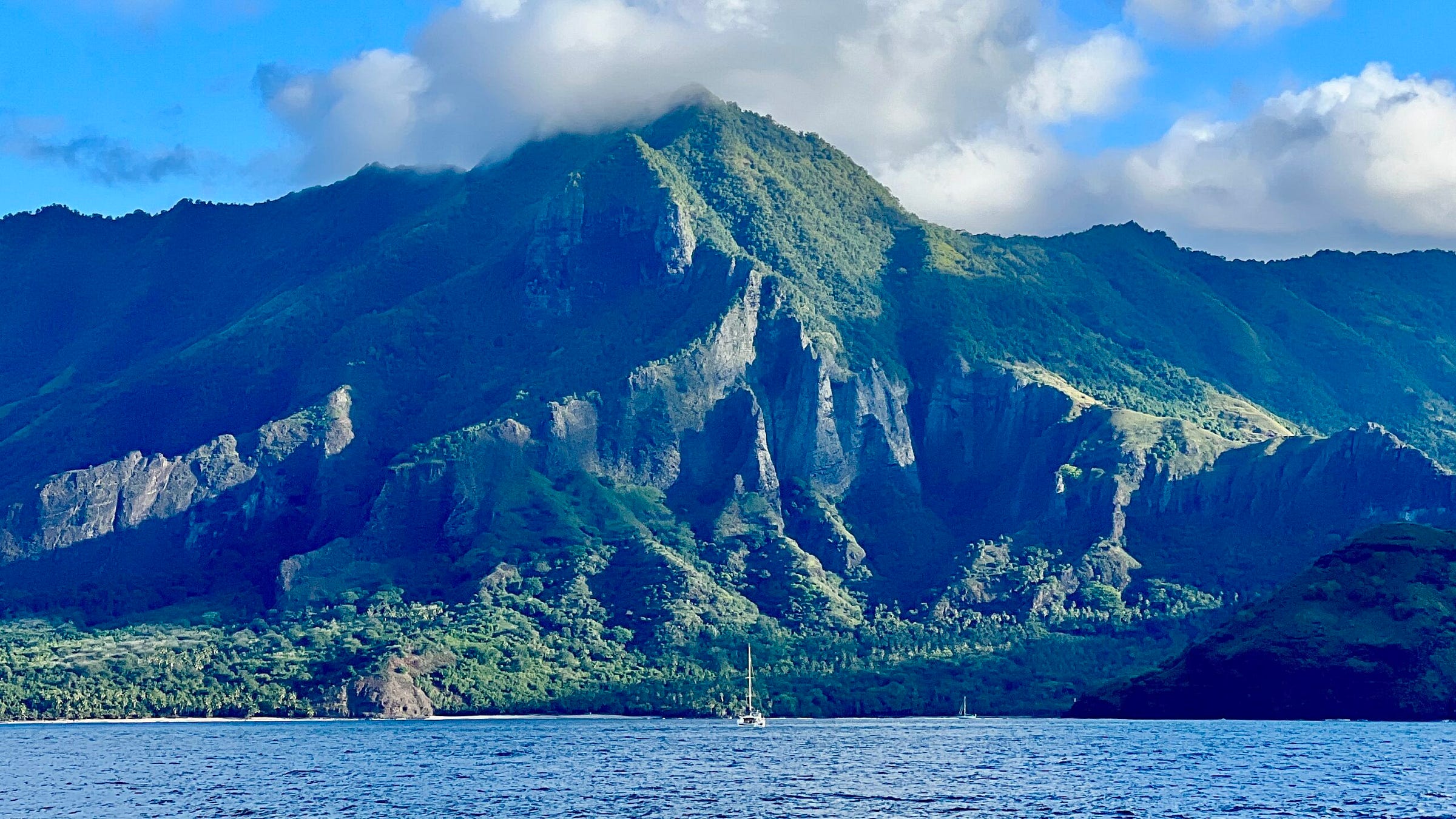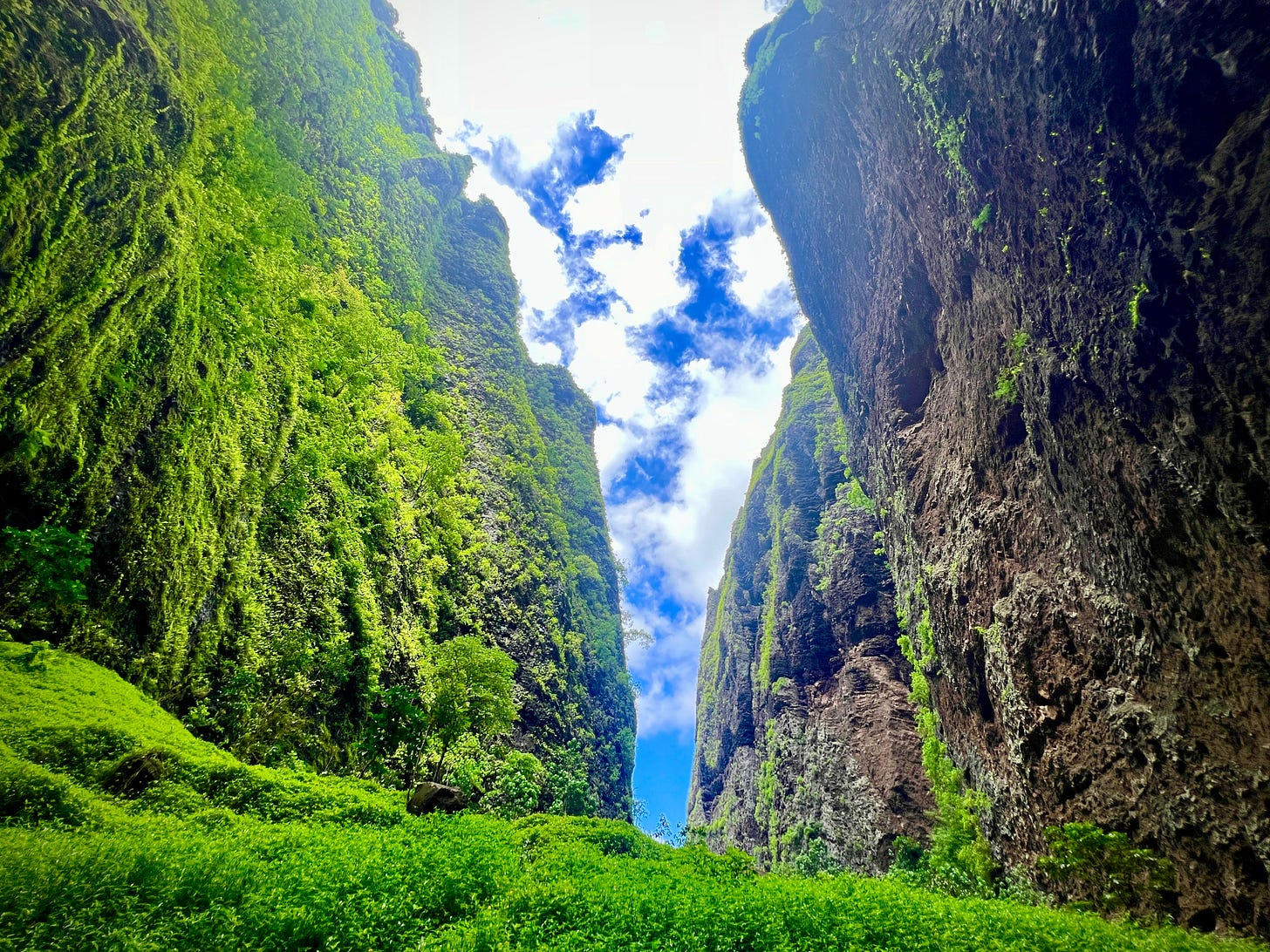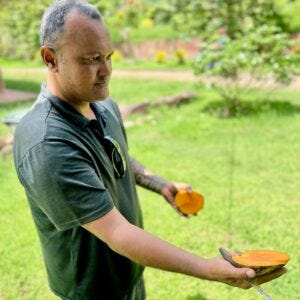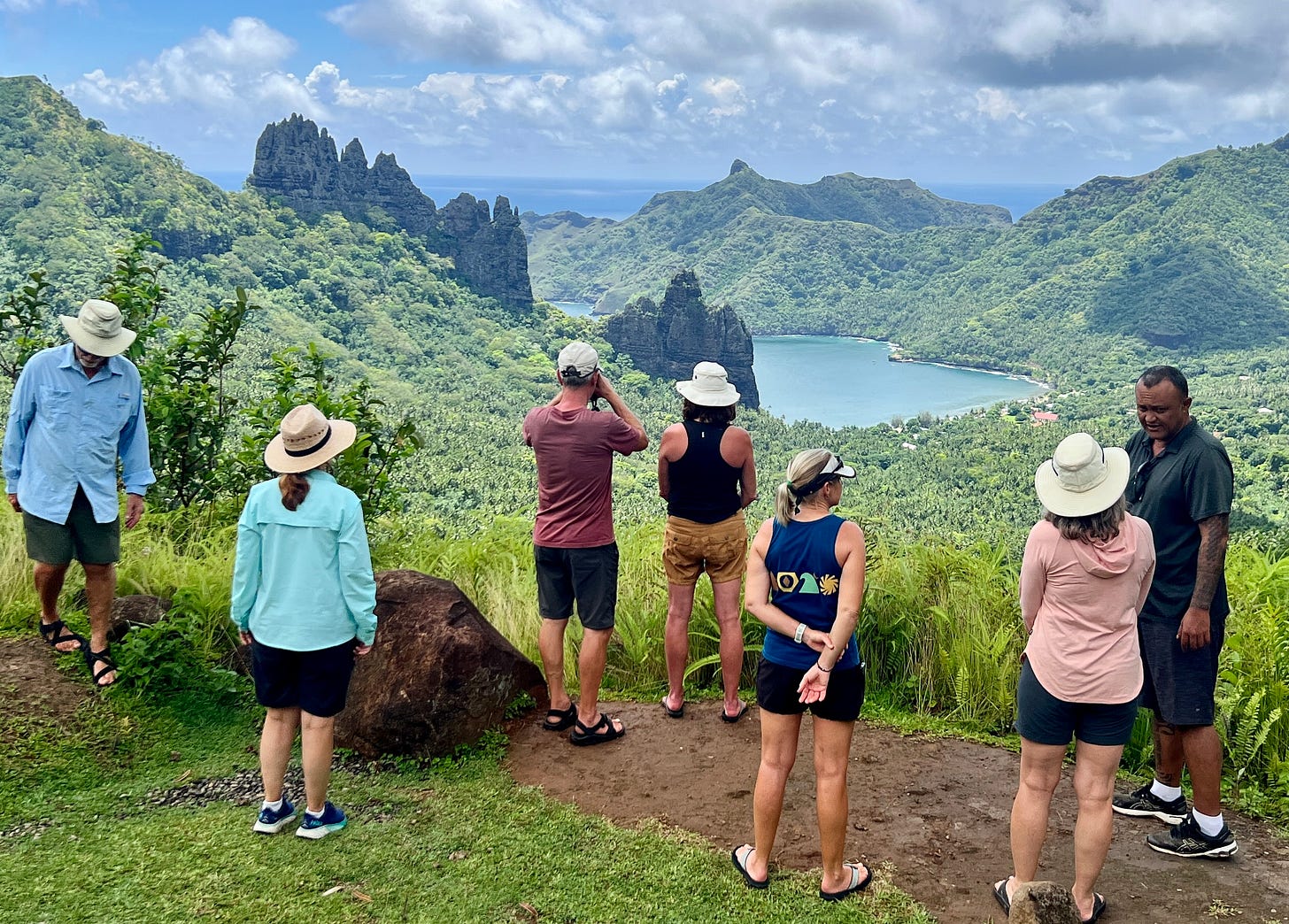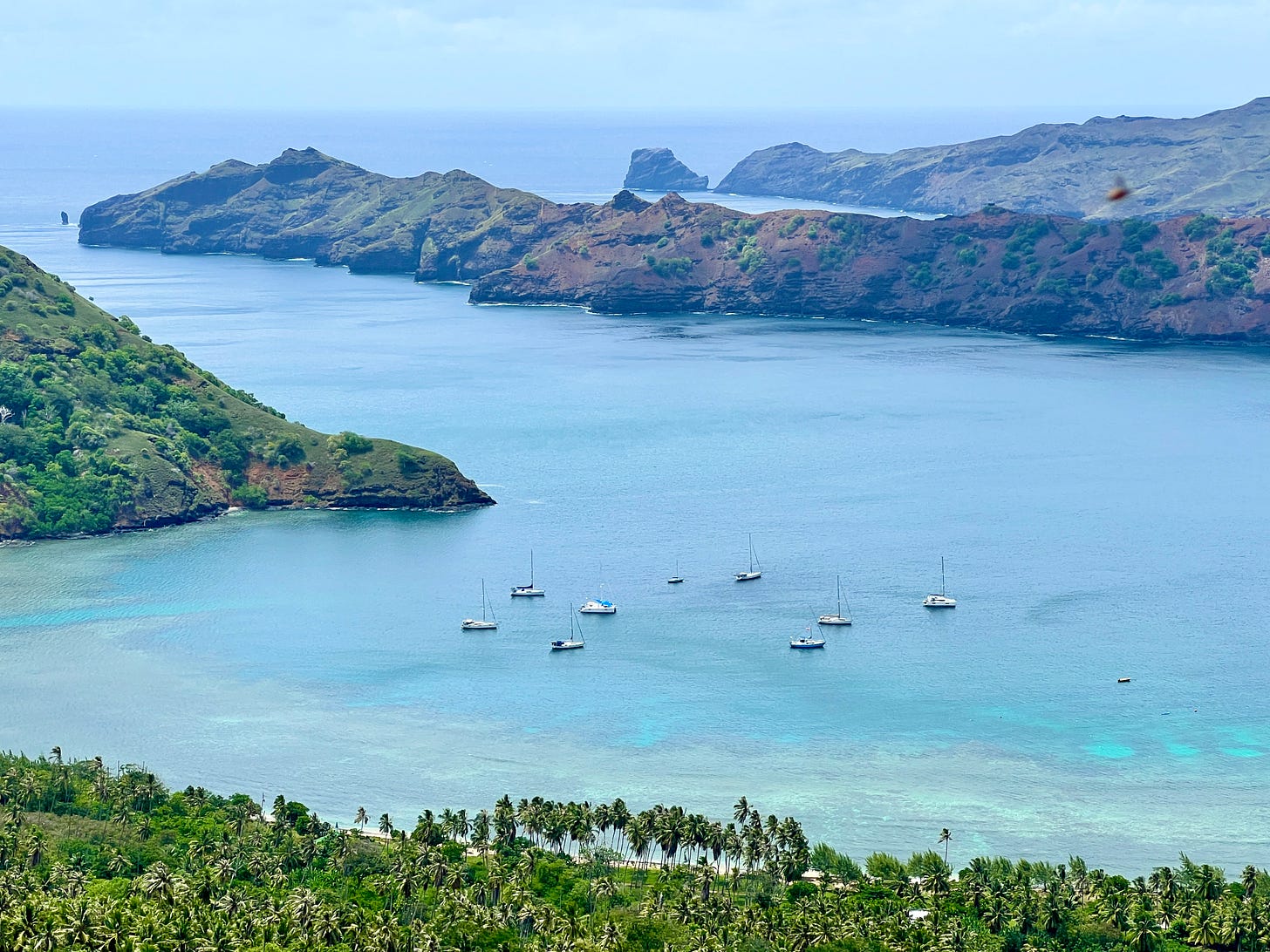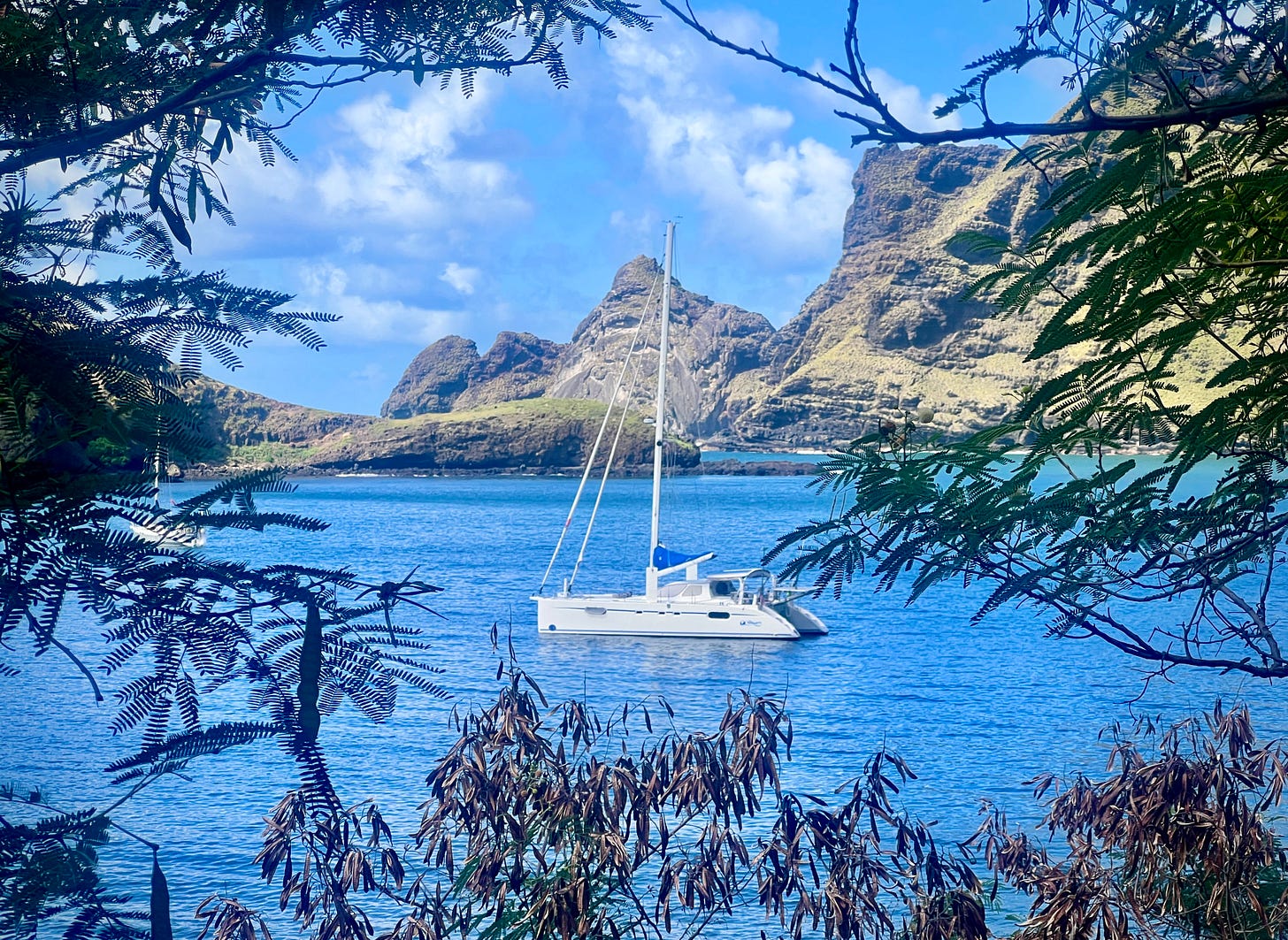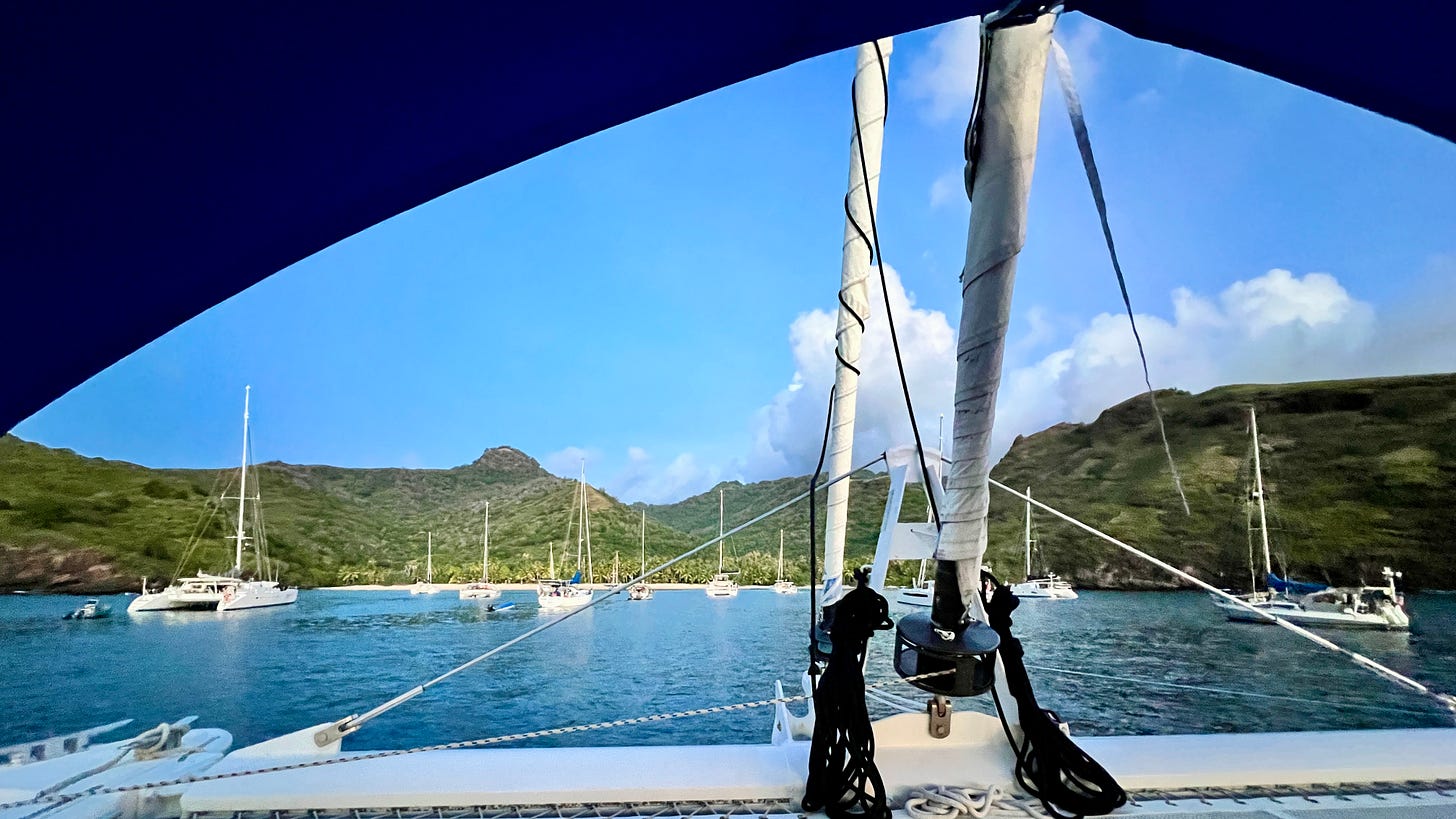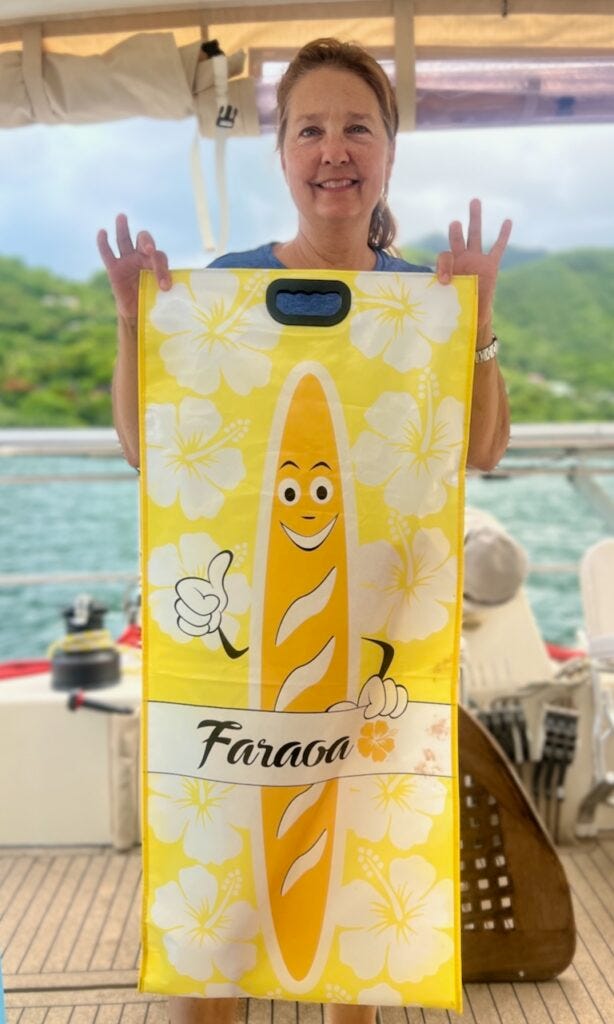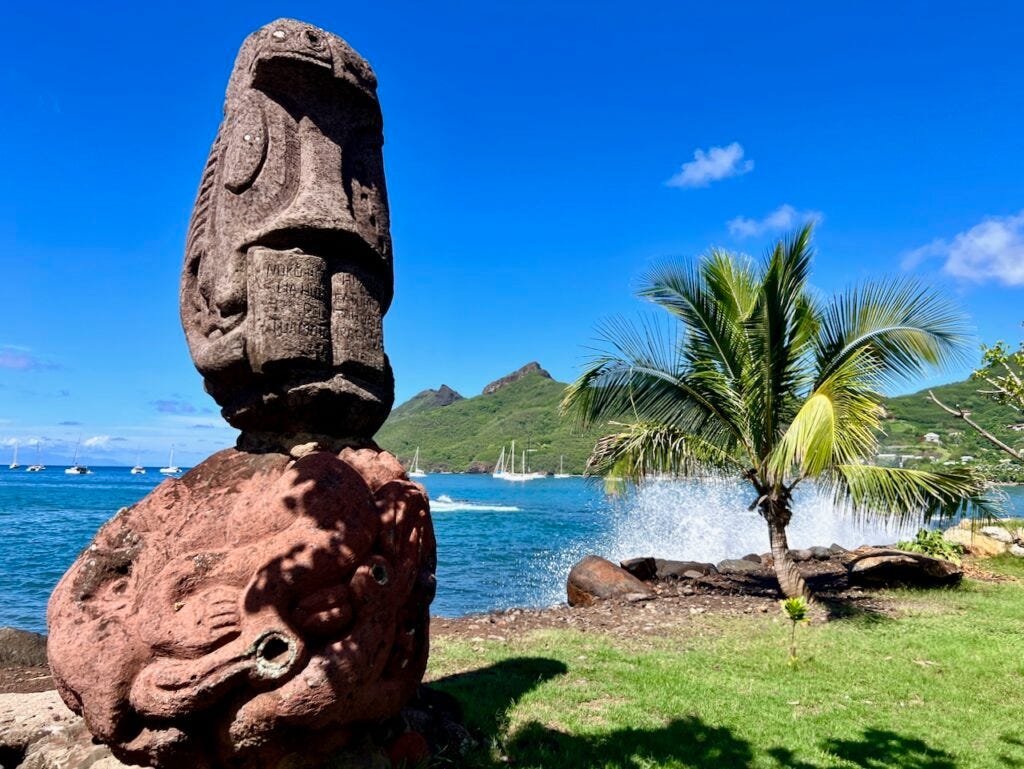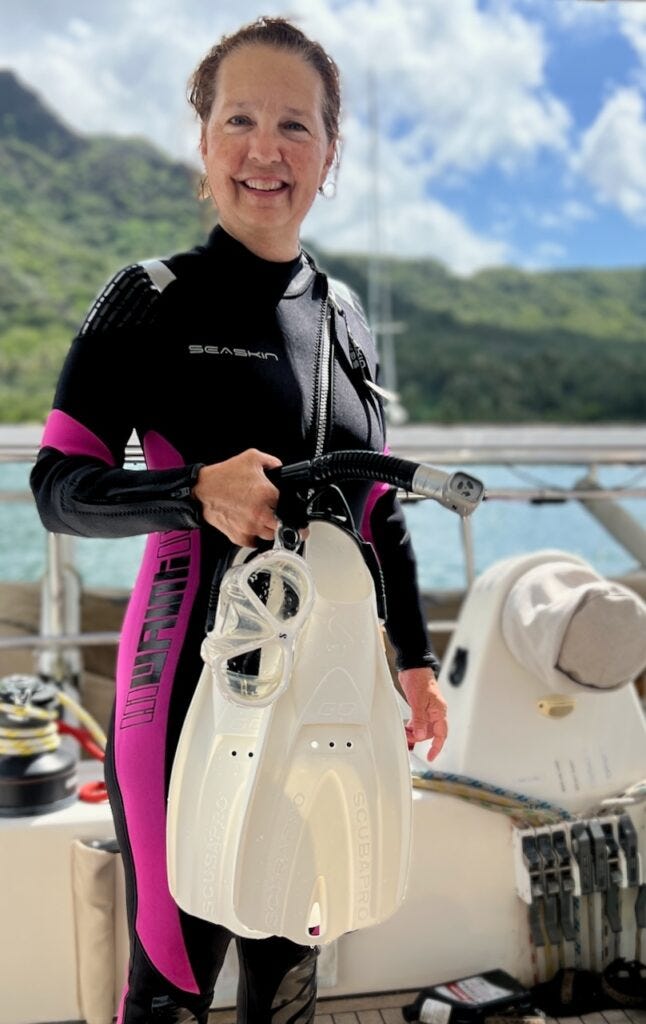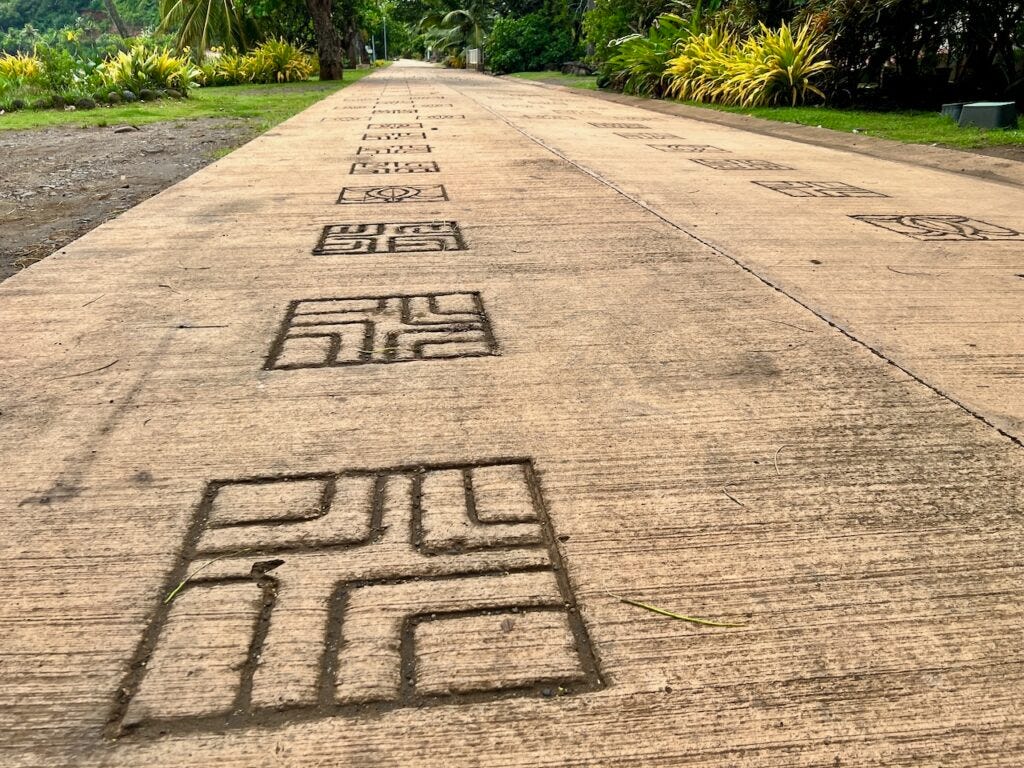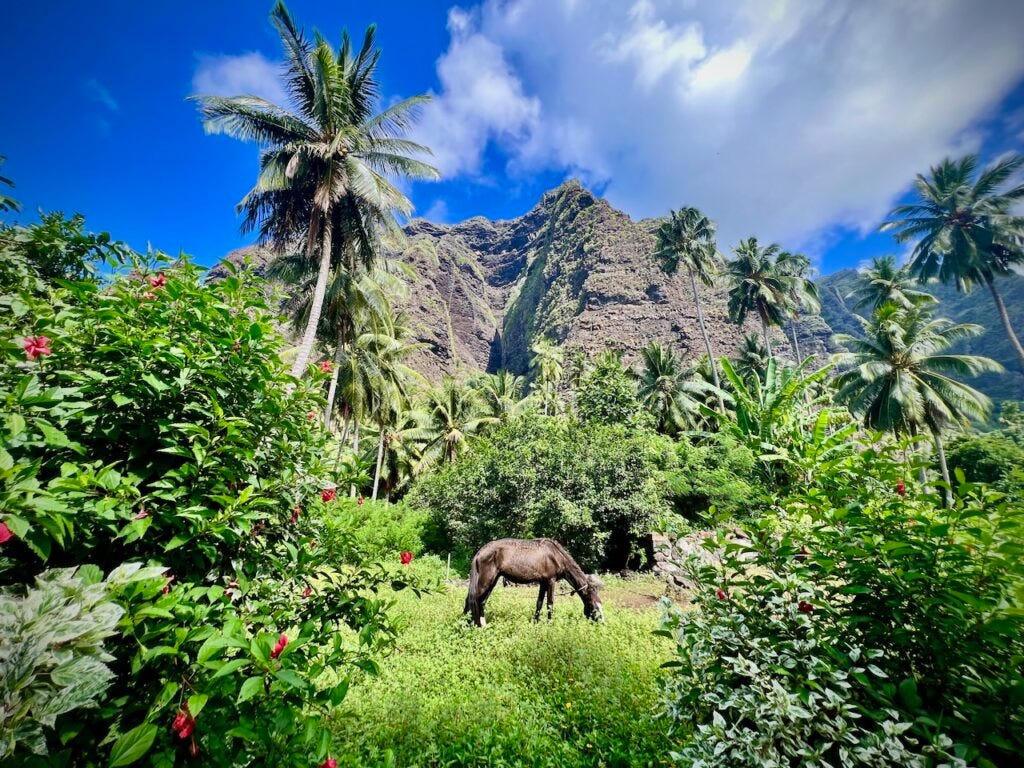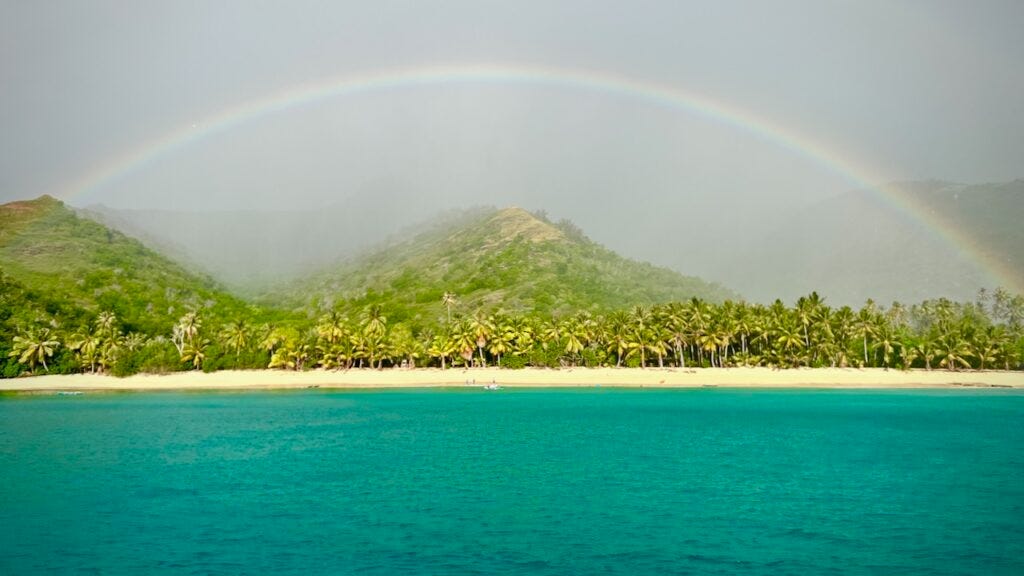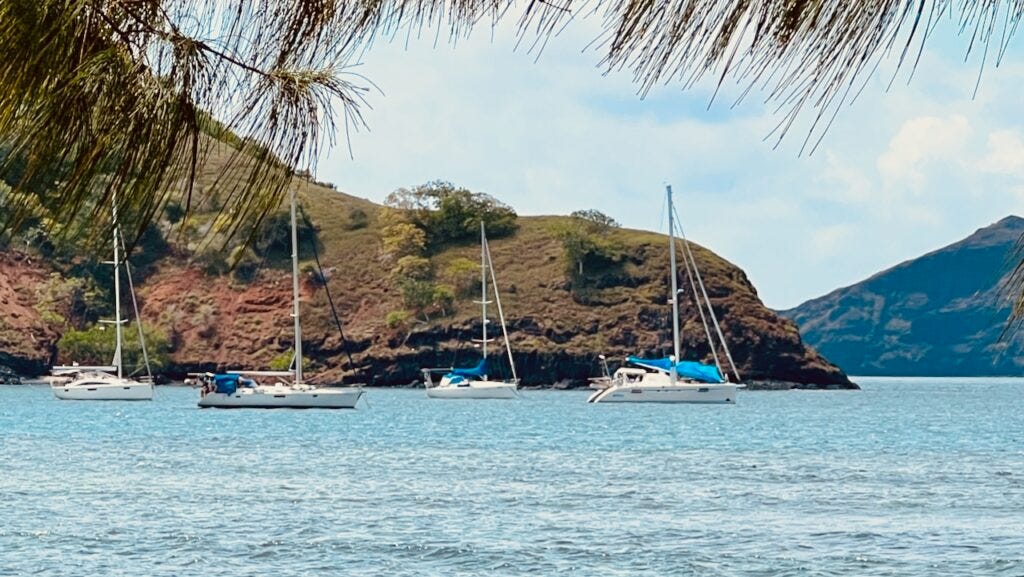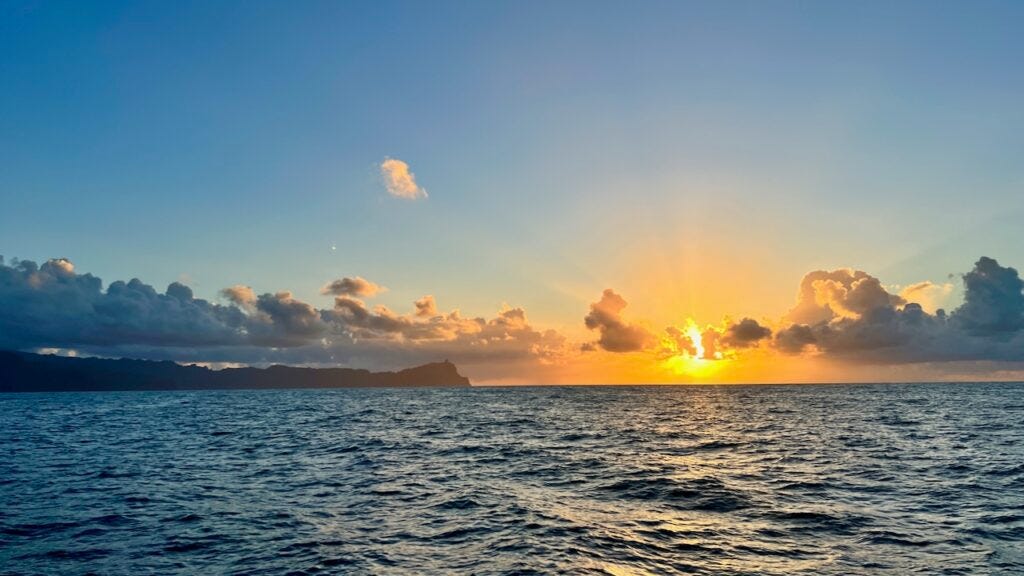The Marquesas
The Adventures of the Sailing Vessel Roam
This is the most beautiful place I have ever seen. Sailors often fantasize about sailing the South Seas and visiting a tropical paradise. The scene they envision is the Marquesas Islands. Since our landfall, we've spent the past few weeks exploring the Marquesan Islands of Nuku Hiva and Tahuata. It is a magical place.
Like the Hawaiian islands, these grand, majestic, extinct volcanoes are covered by lush tropical jungles and rise out of the ocean to tower over the coves and bays where we anchor.
Unlike Hawaii, there is an almost complete absence of tourism and development. Approximately 9,000 people inhabit the Marquesas. Compare that to the overall population of 280,000 for all of French Polynesia, of which the Marquesas are a part.
As a holiday destination, only 16,000 tourists visit the Marquesas each year, roughly the number of people who raft down the Colorado River through the Grand Canyon. The islands see 600 - 700 private yachts in a given cruising season. Contrast that with nearby Bora Bora, which sees about 100,000 visitors; Tahiti with about 200,000; and Hawaii with over 10 million tourists. By comparison, there is nobody here!
A Brief History of the Marquesas
The Marquesas were originally settled by the Polynesians around 300 AD (who also went on to discover and settle Hawaii). They were later sighted by Europeans in 1595 when Spanish explorer Álvaro de Mendaña de Neira stumbled upon them. He named them after his patron, the Marquis of Cañete, the Viceroy of Peru, hence the name "Marquesas."

Although briefly possessed by the US in 1813, it was the French who defined the culture and modern history of the islands. In the 19th century, European powers, including the French, became more interested in the strategic and economic potential of the Pacific islands. The French took formal possession of the Marquesas in 1842 when Admiral Abel Du Petit-Thouars claimed them for France, incorporating them into the broader entity of French Establishments in Oceania. Today, the islands of French Polynesia remain an "overseas collectivity of France," under French administration and part of the French Republic.
The impact of colonialism and Christian missionaries on these islands is profound. The influence of the French government is evident in the infrastructure, language, and cuisine. The church remains the center of village life. Unfortunately, it wasn't until the 1960s that it became legal for islanders to speak the original Marquesan language or wear traditional Marquesan tattoos. Consequently, many generations of stories, history, and culture have been lost, including the significance of the intricate designs seen in the famous Marquesan tattoos. Despite these losses, the islanders maintain a strong sense of pride in their French heritage.
The islands export copra, fruit, and tuna. But the job everyone wants is that of a government functionary. Secure a role in the government, and you are set.
It amazes me that with all the available capital sloshing around in the world, developers haven't yet found this place and built a Four Seasons and a golf course. Not that I am encouraging them.
A Day With Temarama Richard Deane
A few days after our arrival, friends arranged a day with a local guide, Temarama Richard Deane, a 5th-generation Marquesan and a long-time professional guide on the island. He is the go-to guide for visiting dignitaries and served as a "fixer" for the season of Survivor filmed on the island. Seven of us spent the day riding around Nuku Hiva in his specially configured Toyota pickup truck, visiting some of the villages and archaeological sites, and hearing stories of the history and culture of the Marquesas.
Richard (he insisted we call him Richard) is a parent of two kids. Just as he did, they go to boarding school in Tahiti. All Marquesan kids go off to boarding school in Tahiti once they complete elementary school on the island. And, like most modern parents, he hates the influence of social media and cell phones on his kids.
If you ask Richard, a man who has built his career on tourism, he’ll tell you that he’d like to see a bit of tourism growth — maybe from 16,000 visitors to 18,000 visitors a year. No more than that. I didn’t have the heart to tell him that it won’t take many Instagram photos to go from 16,000 visitors to 16 million. Add another 200 meters to the airport runway and a little development capital, and you'll have Hawaii!
By the time the afternoon rolled around, the island was awash in torrential rain, causing flash flooding. Richard roared down off the mountain on the island's one road, plowing through rivers, mud, and debris that were flowing all around us. He delivered us safely, wet and shivering, back to the dingy dock.
Taioha'e was a fantastic spot for relaxing, walking, dining, and stocking up on groceries, but we were excited to venture out and discover other villages and anchorages on the island. We set off to circumnavigate the island in the company of two other boats, Chaos, the Beneteau First 47.7 with whom we buddy-boated across the Pacific, and Fundango, a Bavaria Vision 46 who are long-time sailing friends of Chaos. Fundango is starting their second year in French Polynesia, having done the crossing from Mexico last year. They have become wonderful guides and mentors for us.
We motored around the eastern side of Nuku Hiva to reach Anaho Bay on the northeast corner of the island. A few days later, we sailed around the northern and eastern coasts to Anse Uauka, also known as “Daniel’s Bay” (after the late inhabitant who provided services to visiting sailboats) on the southwest corner.
Baie Anaho
Anaho Beach features Kao Tiae, a small bed and breakfast (a "pension" in French) with some well-kept tents and cots. The guests we met were mostly young Dutch travelers. The hostess there will take your dinner reservation that morning and serve a préfixe meal at a table on the beach that evening. She works with local ingredients, including fresh fish for poisson cru, local beef and pork, and fried breadfruit. We ate there twice. The anchorage was a great spot for hiking the mountains and snorkeling the reefs.
Anse Uauku
It was while anchored in Anse Uauka (Uauka Cove) that we hiked 6 miles through the jungle on the Hakaui trail to visit the Vaipô Waterfall. It’s a stunning hike, with the trail following the river through some ancient ruins and ending at a 300-meter hidden waterfall. The trail passes through some private land, the owners of which collect a small toll as you hike through. One enterprising lady takes reservations for lunch, and on your return hike, she serves an outdoor sit-down meal of mango salad, fresh grilled tuna, fried breadfruit, and fried bananas. A wonderful and appreciated treat after a long, rugged hike.
Tahuata
We departed Anse Uauka for the 86-mile overnight sail south to the island of Tahuata and Hanamoenoa Bay. This was our first overnight sail with just the two of us since we started this cruise. There, we anchored for the better part of the week amongst a dozen other boats. The bay features a pristine white-sand beach and a great snorkeling reef on both sides. We were able to reach the nearby village of Vaitahu via dinghy and stock up on groceries.
Our plan was to spend a week or so exploring Tahiti and the island of Fatu Hiva further south while waiting for good weather to cross over to the Tuamotus, the next archipelago, typically a two- or three-day ocean passage.
Back to Nuku Hiva
Life is what happens when you are making other plans. An urgent family situation arose back home. We decided it would be best to sail back up to Nuku Hiva, where we could leave the boat anchored in Taioha’e Bay and catch a flight to Papeete and then onto Los Angeles. It was a delightful and easy broad reach under a bright moon that was only disrupted by a rain squall in the last eight miles. We anchored again in Taioha’e Bay at dawn the next morning. Kevin at Yacht Services Nuku Hiva will keep an eye on Roam for us while we are away, which is one of the many services they offer.
Boat Repairs to Date
Definition of cruising on a sailboat: "Repairing your boat in expensive, inconvenient, faraway places..." For my fellow boat geeks, here is what we've had to repair since leaving Mexico. Honestly, this is not too bad given the demands of this trip so far.
Re-rove the #1 and #2 mainsail reef outhaul lines to remove the severe chafe. Bringing new 10mm Dyneema-cored lines with a Dyneema chafe sleeve on the last 2 meters of the reef line when we come back from the States. That should solve the problem for good.
Replaced the water maker membranes. The TDS (total dissolved solids) is still high, so more work is to be done. My current theory is that we are getting seawater contamination through the membrane tube end-cap o-rings.
Replaced the starboard water system pump. Failed micro switch.
Port helm seat broke off the pedestal. Removed for now. Looking for a local fiberglass guy to do the basic glass work. I could do it, but it would take me four times as long, and I'd probably have to do it twice to get it right.
Replaced the charging socket in the port, aft guest room (thank you, Sparky).
New inner tubes in the dingy wheels (thank you, Sparky).
Replaced the fan in our stateroom (thank you, Sparky).
A Few Photos:
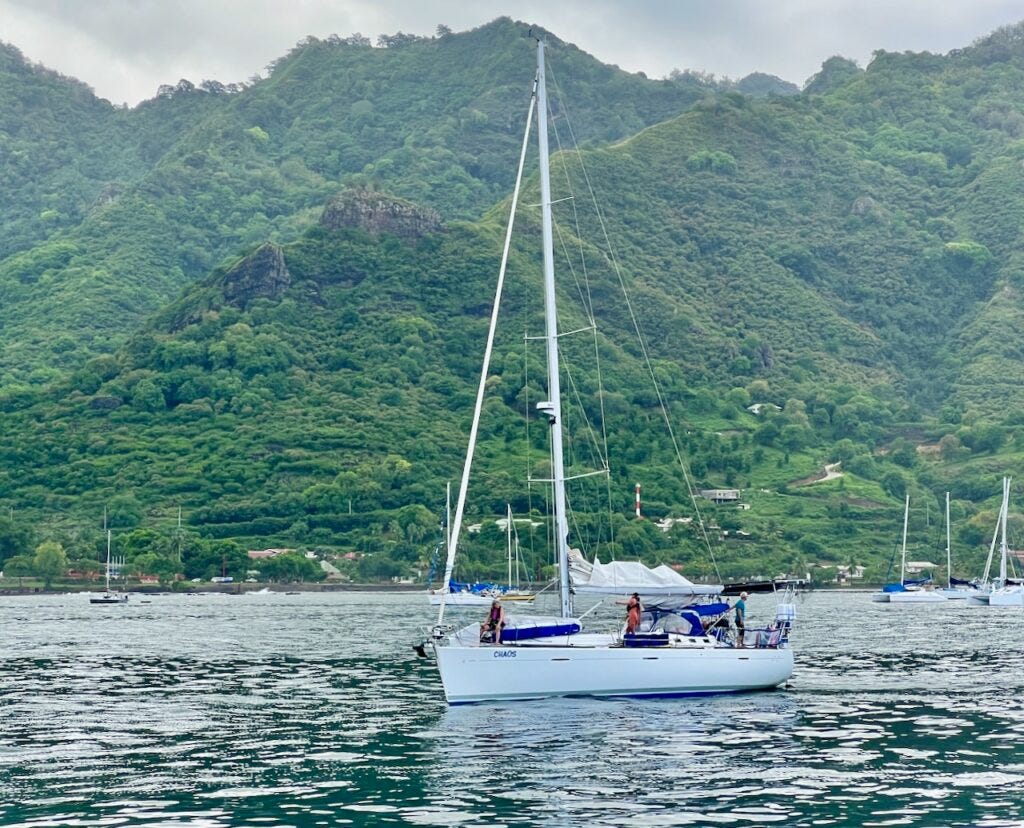
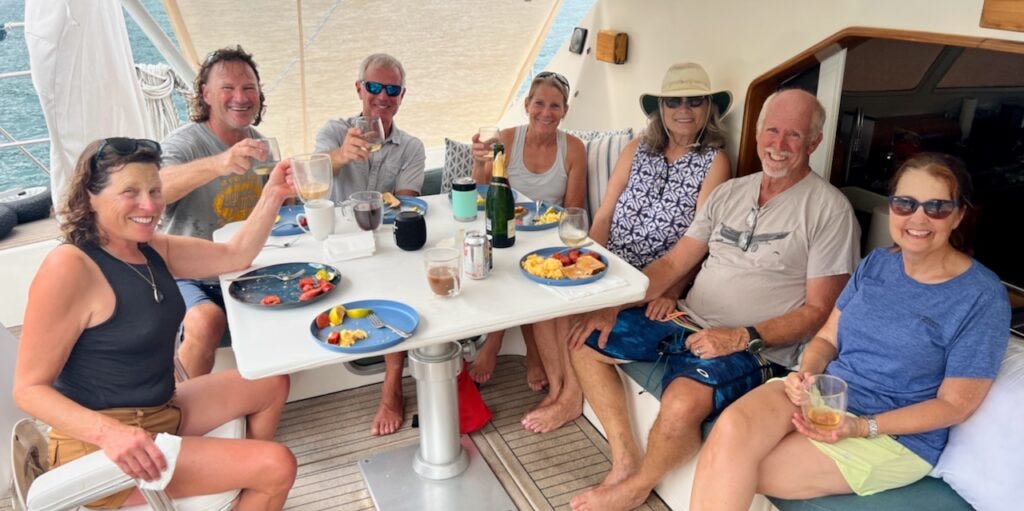

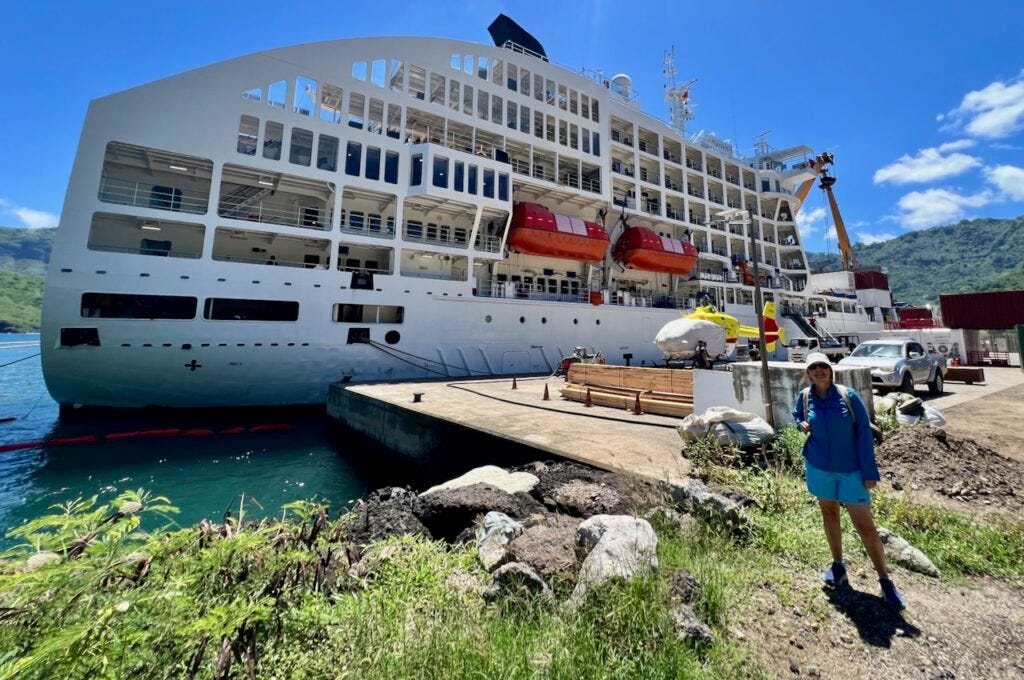
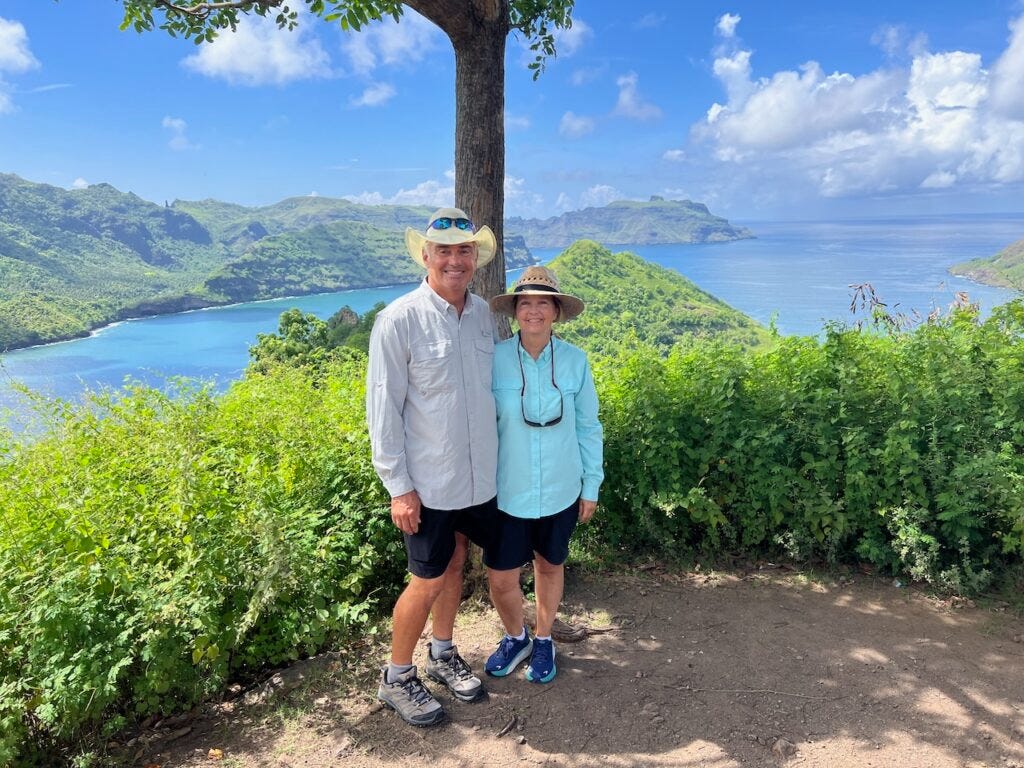
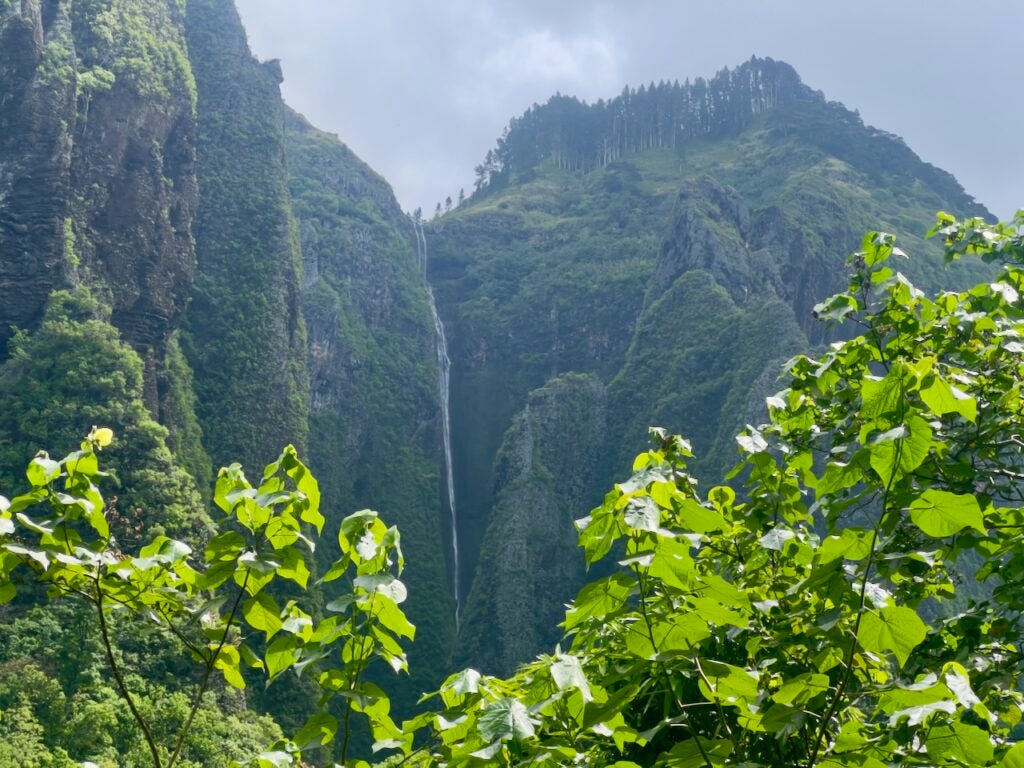
Excperts From the Ship’s Log:
Baie de Anaho
Thu Apr 19 2024 03:46:00 UTC, 8 49.301S 140 03.869W
All is well. We are presently anchored off a small settlement in Anaho Bay (Baie de Anaho) on the northeast corner of Nuku Hiva. We took advantage of the very light winds today to motor around the eastern side of the island to spend some time exploring the north side.
Taiohae Bay is a busy port and very convenient for getting checked in and grocery shopping. But it is time to move on and see more of the island’s anchorages.
We also filled up our gas cans for our dinghy outboard at the island’s only gas station. Where we are headed next has many places to dive and we will need the dinghy to reach them. But there aren’t many places to get gas. We need to bring a lot with us. Our friend and anchorage neighbor, Mark, came along to help me. Getting 20 gallons of gas down a 20-foot concrete wharf is best done with help.
Yesterday we joined some friends and spent the day touring the island with Richard, a local guide. It was a wonderful experience. I’ll write a proper post shortly about it. The day ended with all 7 of us in Richard’s pickup trying to outrun the flash flooding from the torrential rain that snuck up on us in the afternoon.
Anse Hakatea (aka Daniel’s Bay)
Tue Apr 23 2024 03:31 UTC, 8 56.628S 140 09.872W
All is well. We are presently anchored in Anse Hakatea, also known to cruising sailors as “Daniel’s Bay” after the late inhabitant who looked after visiting cruising boats.
We’ve completed our circumnavigation of Nuku Hiva, departing Anaho Bay this morning and sailing along the northern and western coasts of the island. It is without a doubt the most beautiful island I’ve ever seen.
We are here to hike into the jungle tomorrow to a hidden waterfall.
If the weather holds, we’ll depart for the hundred-mile sail to Hiva Oa on Wednesday.
Farewell Nuku Hiva
Wed Apr 24 2024 20:09 UTC 9 54.493S 139 06.320W
All is well. We are presently anchored in Hanamoenoa Bay on the Marquesan island of Tahuata. It features crystal-clear water and one of the few white-sand beaches in the Marquesas.
We made the 86-nautical-mile sail through the night last night, departing Daniel’s Bay, Nuku Hiva, at 17:45 and arriving here at 10:20 this morning. It was a glorious full moon with 11-14 knots of breeze, close-hauled the entire way, under a reefed main, Solent, and full daggers. A trip that should put to rest any doubts that performance cats can’t go upwind.
This was also Pam and my first overnight together on the boat.
We plan to spend a week or two here, at Hiva Oa next door, and at Fatu Hiva a bit further south while waiting for good weather to head for the Tuamotus.
Nuku Hiva Redux
Mon Apr 29 2024 17:08 UTC, 8 54.967S 140 06.234W
All is well. We are once again anchored in Taiohae Bay, Nuku Hiva, after a delightful, fast overnight sail from Hanamoenoa Bay on the island of Tahuata. Broad reaching in the moonlight with a single reefed main and Jack Reacher the Code65. Slight 3’ quartering seas.
Only one lone rain shower with eight miles left to go spoiled the otherwise perfect trip by getting everything wet, forcing me to roll up Jack, and then sucking the wind out of the area.
But here we are. Kevin and the crew of Yacht Services Nuku Hiva will keep an eye on Roam in the anchorage while we fly back to the States to tend to some urgent family matters.
Hopefully, we will be back soon!


